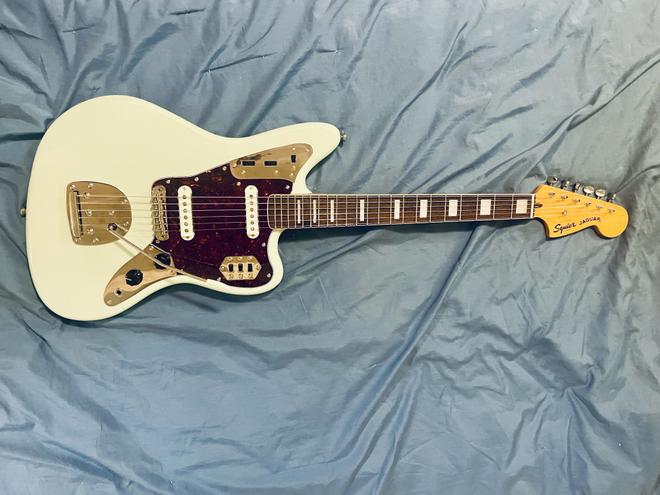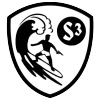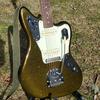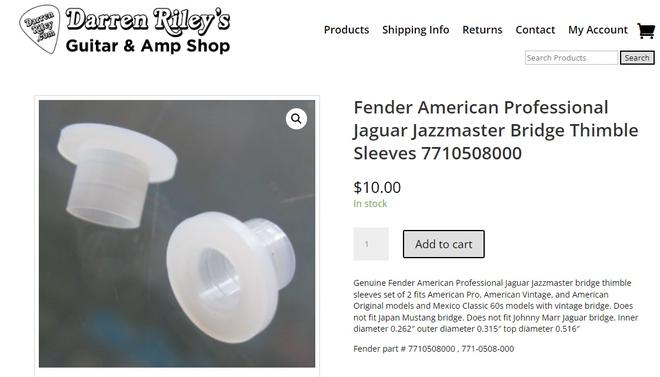Diamond_Dave

Joined: Aug 19, 2024
Posts: 15
Roanoke, Virginia

|

Posted on Aug 24 2024 03:43 PM
I set up my Squier CV 70s Jag today, which I’ve owned for five days. So these come with 9-42 strings from the factory. I changed them to a set of Ernie Ball Power Slinky 11-48, because I felt that a) going to 12s would be a big jump and b) I play 10s on my other guitars, so this is a gauge heavier for the shorter scale.
No real problems with the setup. I used a 0.5 shim (this set from Amazon, which seemed to give me a little extra neck angle but not too much. I put some mineral oil on the fretboard, applied some blue Loctite to the bridge screws, and strung it up. I had to widen the nut slots, but I have a set of the Music Nomad files. Unfortunately they’re meant for 10-46, but I was able to carefully widen the slots by applying sideways rather than downward pressure. The slot depths were already pretty good.
So once it was strung, I took a little relief out of the neck, stretched the strings and checked intonation. You have to be careful to get the bridge where you want it (straight up and down in my case) and not to bump it when you’re setting the intonation. But it intonated just fine. The tremolo was nice bouncy without any adjustment. I raised the pickups slightly and plugged her in…and she really sings. The 11s are much better than to play than those 9s these guitars ship with.
So I’m very pleased. I can see that a Jaguar setup could be more complicated than setting up other guitars, but if you have a few tools, some experience and some patience, it’s not too bad.
Now to really enjoy the guitar!

|
SilverFlash

Joined: Jul 14, 2015
Posts: 478
Near Atlanta, GA




|

Posted on Aug 24 2024 04:36 PM
Congratulations on the new Jaguar, Diamond Dave! I also have a Squier CV 70s Jag. Your experience setting up the guitar sounds like mine. I've had it for a couple of years, and it is a sweet playing guitar. It is my go-to for surf music. I think you will really enjoy it, and, also, welcome to the SG101 site. There is a lot of valuable information and history here. Enjoy the journey.
— -Tim
MyYouTubeChannel
My Classic Instrumental Surf Music Timeline
SSS Agent #777
|
Surfadelphia

Joined: Sep 04, 2017
Posts: 435
|

Posted on Aug 26 2024 01:41 PM
I also have a CV 70's Jag. A set of 11's and a little set-up work goes a long way on these guitars. Mine didn't need a neck shim but I am sure mileage will vary from guitar to guitar. I have no idea why they ship these guitars with 9's given the scale length. Can't get anything even close in that price range.
|
Diamond_Dave

Joined: Aug 19, 2024
Posts: 15
Roanoke, Virginia

|

Posted on Aug 26 2024 10:37 PM
Thanks, folks. Loving this guitar so far!
|
synchro

Joined: Feb 02, 2008
Posts: 4540
Not One-Sawn, but Two-Sawn . . . AZ.





|

Posted on Aug 27 2024 12:43 AM
I have one, which amazes me. I added nylon thimbles to limit bridge motion. There’s actually a Fender part number for that, and I use these thimbles on any Offset with a vibrato. Amazingly, mine required virtually no setup. I bought it at GC and it played well from day one.
— The artist formerly known as: Synchro
When Surf Guitar is outlawed only outlaws will play Surf Guitar.
|
AlienSurf

Joined: Jan 17, 2024
Posts: 17

|

Posted on Aug 27 2024 11:44 AM
Congratulations on the new guitar!
Thanks for sharing your setup details. I picked up a Classic Vibe 70s Jaguar at the end of April from GC. It was happy with setup as delivered.
Very pleased with the quality and sound from this guitar.
— https://distrokid.com/hyperfollow/thealiensurfagenda/short-board-boogie
https://distrokid.com/hyperfollow/thealiensurfagenda/wave-sliders
https://distrokid.com/hyperfollow/thealiensurfagenda/no-surf-on-mars
https://aliensurfagenda.bandcamp.com/
|
Diamond_Dave

Joined: Aug 19, 2024
Posts: 15
Roanoke, Virginia

|

Posted on Aug 27 2024 12:03 PM
Thanks, folks. That was my intent—-to put a few setup details out there!
|
Surfadelphia

Joined: Sep 04, 2017
Posts: 435
|

Posted on Aug 28 2024 11:29 AM
synchro wrote:
I have one, which amazes me. I added nylon thimbles to limit bridge motion. There’s actually a Fender part number for that, and I use these thimbles on any Offset with a vibrato. Amazingly, mine required virtually no setup. I bought it at GC and it played well from day one.
I added the nylon thimbles also. Definitely helps with tuning stability. If you can't find the official Fender nylon thimbles/inserts there are a couple venders on Reverb who sell generic versions for a bit less $$$. Probably something you can find in a good hardware store if you know the dimensions.
Last edited: Aug 28, 2024 11:30:48
|
synchro

Joined: Feb 02, 2008
Posts: 4540
Not One-Sawn, but Two-Sawn . . . AZ.





|

Posted on Aug 28 2024 06:25 PM
Surfadelphia wrote:
synchro wrote:
I have one, which amazes me. I added nylon thimbles to limit bridge motion. There’s actually a Fender part number for that, and I use these thimbles on any Offset with a vibrato. Amazingly, mine required virtually no setup. I bought it at GC and it played well from day one.
I added the nylon thimbles also. Definitely helps with tuning stability. If you can't find the official Fender nylon thimbles/inserts there are a couple venders on Reverb who sell generic versions for a bit less $$$. Probably something you can find in a good hardware store if you know the dimensions.
My local Ace hardware has them for about fifty cents each, although they are too tall, and would require a bit of surgery.
— The artist formerly known as: Synchro
When Surf Guitar is outlawed only outlaws will play Surf Guitar.
|
Diamond_Dave

Joined: Aug 19, 2024
Posts: 15
Roanoke, Virginia

|

Posted on Aug 29 2024 11:36 AM
My bridge barely moves when I use the tremolo. A slight rock forward and a slight rock back. I don't have any experience with these types of bridges and trems, but it doesn't seem like it's unstable. The string tension keeps the strings firmly planted on the bridge.
|
synchro

Joined: Feb 02, 2008
Posts: 4540
Not One-Sawn, but Two-Sawn . . . AZ.





|

Posted on Aug 29 2024 12:06 PM
Diamond_Dave wrote:
My bridge barely moves when I use the tremolo. A slight rock forward and a slight rock back. I don't have any experience with these types of bridges and trems, but it doesn't seem like it's unstable. The string tension keeps the strings firmly planted on the bridge.
I’ve personally had a Jaguar bridge topple, on a gig. It’s a good design, but as you mention, the bridge barely moves when you use the trem’, so having these thimbles doesn’t strike me as a hinderance and can prevent the bridge from toppling. That happened 10 years ago, and I can promise you, it was not a good day.
— The artist formerly known as: Synchro
When Surf Guitar is outlawed only outlaws will play Surf Guitar.
|
Diamond_Dave

Joined: Aug 19, 2024
Posts: 15
Roanoke, Virginia

|

Posted on Aug 29 2024 01:44 PM
synchro wrote:
Diamond_Dave wrote:
My bridge barely moves when I use the tremolo. A slight rock forward and a slight rock back. I don't have any experience with these types of bridges and trems, but it doesn't seem like it's unstable. The string tension keeps the strings firmly planted on the bridge.
I’ve personally had a Jaguar bridge topple, on a gig. It’s a good design, but as you mention, the bridge barely moves when you use the trem’, so having these thimbles doesn’t strike me as a hinderance and can prevent the bridge from toppling. That happened 10 years ago, and I can promise you, it was not a good day.
Do you have a Jaguar or Mustang bridge? I have a Mustang bridge, but I think the only difference is that the Mustang bridge has a single groove for the string.
How did the bridge topple? Did it lean too far forward and pop out of the thimbles altogether?
|
synchro

Joined: Feb 02, 2008
Posts: 4540
Not One-Sawn, but Two-Sawn . . . AZ.





|

Posted on Aug 29 2024 04:05 PM
Diamond_Dave wrote:
synchro wrote:
Diamond_Dave wrote:
My bridge barely moves when I use the tremolo. A slight rock forward and a slight rock back. I don't have any experience with these types of bridges and trems, but it doesn't seem like it's unstable. The string tension keeps the strings firmly planted on the bridge.
I’ve personally had a Jaguar bridge topple, on a gig. It’s a good design, but as you mention, the bridge barely moves when you use the trem’, so having these thimbles doesn’t strike me as a hinderance and can prevent the bridge from toppling. That happened 10 years ago, and I can promise you, it was not a good day.
Do you have a Jaguar or Mustang bridge? I have a Mustang bridge, but I think the only difference is that the Mustang bridge has a single groove for the string.
How did the bridge topple? Did it lean too far forward and pop out of the thimbles altogether?
That particular guitar had a Mustang bridge. It was a MIJ Jaguar, circa 2011. It was a pretty decent guitar, overall.
The bridge simply tipped in the direction of the neck, and was cocked in the thimbles. It was a simple fix, simply put it back on the needlepoint of the height adjusting screws, but that’s a hekuva thing to have happen in the middle of a song.
In this case, it was at an outdoor gig, with no shade. Just three guys out in the Arizona sun. I was using a solid body that day, because I knew it would be hot and I didn’t want to bake my Gretsch in the sun. It was the first gig I used that Jaguar on, and the last. Had I known about bridge thimbles, chances are I never would have sold it. I currently have four Offsets, three with rocking bridges, and all three of these have the bridge thimbles.
— The artist formerly known as: Synchro
When Surf Guitar is outlawed only outlaws will play Surf Guitar.
|
Diamond_Dave

Joined: Aug 19, 2024
Posts: 15
Roanoke, Virginia

|

Posted on Aug 29 2024 06:39 PM
synchro wrote:
Diamond_Dave wrote:
synchro wrote:
Diamond_Dave wrote:
My bridge barely moves when I use the tremolo. A slight rock forward and a slight rock back. I don't have any experience with these types of bridges and trems, but it doesn't seem like it's unstable. The string tension keeps the strings firmly planted on the bridge.
I’ve personally had a Jaguar bridge topple, on a gig. It’s a good design, but as you mention, the bridge barely moves when you use the trem’, so having these thimbles doesn’t strike me as a hinderance and can prevent the bridge from toppling. That happened 10 years ago, and I can promise you, it was not a good day.
Do you have a Jaguar or Mustang bridge? I have a Mustang bridge, but I think the only difference is that the Mustang bridge has a single groove for the string.
How did the bridge topple? Did it lean too far forward and pop out of the thimbles altogether?
That particular guitar had a Mustang bridge. It was a MIJ Jaguar, circa 2011. It was a pretty decent guitar, overall.
The bridge simply tipped in the direction of the neck, and was cocked in the thimbles. It was a simple fix, simply put it back on the needlepoint of the height adjusting screws, but that’s a hekuva thing to have happen in the middle of a song.
In this case, it was at an outdoor gig, with no shade. Just three guys out in the Arizona sun. I was using a solid body that day, because I knew it would be hot and I didn’t want to bake my Gretsch in the sun. It was the first gig I used that Jaguar on, and the last. Had I known about bridge thimbles, chances are I never would have sold it. I currently have four Offsets, three with rocking bridges, and all three of these have the bridge thimbles.
Yikes! I noticed in the store that the bridge would tip forward or back and “lock.” These are finicky contraptions for sure.
|
synchro

Joined: Feb 02, 2008
Posts: 4540
Not One-Sawn, but Two-Sawn . . . AZ.





|

Posted on Aug 30 2024 01:36 AM
Diamond_Dave wrote:
Yikes! I noticed in the store that the bridge would tip forward or back and “lock.” These are finicky contraptions for sure.
When I started playing, one of my first dream guitars was a Jaguar. When I got old enough to work, and could afford a decent guitar on my own, I thought about a Jaguar, but was warned to stay away from them, because of their reputation for bridge issues.
Flash forward several decades and these issues are easy to address. There are any number of bridge options these days, ranging from the jewelry like Mastery to just buying an OEM Mustang bridge. I somewhat split the difference and use StayTrem bridges on my Warmoth Jaguar and my Bass VI. IMO, the StayTrem is an excellent product, and a true bargain. My Squier CV ‘70s Jaguar has the OEM Squier bridge, which is of the Mustang style. I’ve had that guitar for a year and a half and have yet to have any bridge problems. I use the nylon thimbles on all of them. With those simple mods, I’ve tamed my Offset’s bridge problems and made them as reliable as a guitar can be.
— The artist formerly known as: Synchro
When Surf Guitar is outlawed only outlaws will play Surf Guitar.
|
Diamond_Dave

Joined: Aug 19, 2024
Posts: 15
Roanoke, Virginia

|

Posted on Aug 30 2024 08:02 AM
For me, I think any chance of toppling has been reduced or eliminated by shimming the neck and playing 11s, which increases the break angle and the downward pressure on the bridge. I’ve never tried to topple it, mostly because I’d rather play it than intonate it again. In the store, the guitar was unshimmed with 9s on it.
|
Surfadelphia

Joined: Sep 04, 2017
Posts: 435
|

Posted on Aug 30 2024 12:34 PM
Diamond_Dave wrote:
For me, I think any chance of toppling has been reduced or eliminated by shimming the neck and playing 11s, which increases the break angle and the downward pressure on the bridge. I’ve never tried to topple it, mostly because I’d rather play it than intonate it again. In the store, the guitar was unshimmed with 9s on it.
My 70's Squier Jag didn't need the shim (was just lucky with the angle of the neck pocket) but changing out the stock 9's for 11's is a game changer. With 9's the bridge saddles would literally just move all over the place, had horrible tuning stability buzzed like crazy, and sounded "thin". I'm not a "if you don't put bridge cables on your guitar the tone will suck" guys but 9's just do not work on a Jag...well at least for me.
Last edited: Aug 30, 2024 12:35:16
|
IceratzSurf

Joined: Oct 22, 2022
Posts: 290

|

Posted on Aug 30 2024 01:54 PM
There are probably other resources for the bridge nylon thimble inserts, but I have bought numerous ones from this site below.
If you look closely, the shafts have slight relief ribs in the sides. This effectively allows the bridge to rock when using the tremelo, while providing solid stability.
I believe this is standard Fender equipment for the AM Jazzmaster Pro bridge setup.
I have modified 2 Jaguars, MIM and an Indo Squier with both converted to the AM Pro bridges, with the metal thimbles and the nylon inserts.
The tuning stability is notable and I use the tremelo constantly.
I have also tried the electrical tape shim method of wrapping the bridge shafts, but its not an exact science and is definitely not as stable.

|
synchro

Joined: Feb 02, 2008
Posts: 4540
Not One-Sawn, but Two-Sawn . . . AZ.





|

Posted on Aug 30 2024 05:16 PM
IceratzSurf wrote:
There are probably other resources for the bridge nylon thimble inserts, but I have bought numerous ones from this site below.
If you look closely, the shafts have slight relief ribs in the sides. This effectively allows the bridge to rock when using the tremelo, while providing solid stability.
I believe this is standard Fender equipment for the AM Jazzmaster Pro bridge setup.
I have modified 2 Jaguars, MIM and an Indo Squier with both converted to the AM Pro bridges, with the metal thimbles and the nylon inserts.
The tuning stability is notable and I use the tremelo constantly.
I have also tried the electrical tape shim method of wrapping the bridge shafts, but its not an exact science and is definitely not as stable.

I’ve bought from Darren Riley, and have had good results. You can use the Ace Hardware pieces, but a few bucks for the real thing is money well spent, and you don’t have to cut the Fender ones to length.
The concept of rocking bridges makes a lot of sense, but execution is where the battle is won or lost. In order for a stringed instrument, of any sort, to be viable, the bridge has to be in the right place, and it has to be stable. So rocking bridges, by their nature, are a challenge to the necessity of having a stable bridge.
Gretsch guitars, in many cases, use a Bigsby, which is an excellent piece, and many Gretsch guitars came with what is called a “rocking bar bridge”, which is exactly what its name would suggest, a bar bridge that is designed to rock atop its bridge base. I own four Gretsch, but only one has a rocking bar bridge. The other three use aftermarket bar bridges, either Comptons, or a Tru-Arc Rock Solid, and none of the four have any tuning stability issues, even if I do a dive bomb. What I have noticed it that the posts coming out of the bridge base flex slightly when the vibrato arm is moved.
Leo Fender’s approach, when he designed the first Offset, was to have sharp pivots on the height adjustment screws, and this works fairly well. The trem’ arms on my Jaguars and my VI work beautifully. They are both smooth and linear, coming amazingly close to the action of a Bigsby, which is saying something, because a U.S. made Bigsby uses ball bearings and is exceptionally low friction. To make something that operates similarly from three pieces of sheet steel, is a major accomplishment.
However, There’s a lot of bridge excursion possible, because of the inner diameter of the steel wells the bridge pivots within; enough that it can topple, especially if the bridge adjustment screws are extended far enough. I’ve used the tape solution, and it works, but it’s messy, to say the least. A neck shim helps, because the natural break angle over the Jaguar bridge is quite shallow. My Warmoth Jaguar has a 1/2 degree shim, for this very reason. My Squier Jaguar apparently has a slightly angled neck pocket, and the neck angle is perfect. I find it ironic that Fender solved so many Jaguar complaints on an entry level instrument.
I would venture that there are a lot of people on this forum who are quite experienced in setting up Offsets. There are a number of approaches and there are a number of effective approaches. There are also a number of aftermarket bridges out there, and for each bridge design, there are a different set of strengths. My own preference is the Mustang design, which I feel works well. The StayTrem bridge combines the basic Mustang design with threads that prevent the adjustment screws from backing out on their own.
— The artist formerly known as: Synchro
When Surf Guitar is outlawed only outlaws will play Surf Guitar.
|
IceratzSurf

Joined: Oct 22, 2022
Posts: 290

|

Posted on Aug 30 2024 06:57 PM
When I set out to modify this Jaguar HH, little did I fully understand the bridge and string break angle issues of most offset guitars.
https://surfguitar101.com/forums/topic/35154/
But after the conversion to single coil and upgraded AM Pro bridge did I realize that the original HH had the tremelo set 1.5" further forward than traditional Jaguar setups, thus allowing more string break angle to the bridge.
Lucky me!
It definitely is more stable than a " correct period" Jaguar layout.
Makes me question why there have not been more discussion on making custom offsets with the tremelo tail shifted forward to accomplish this age old issue?
|































